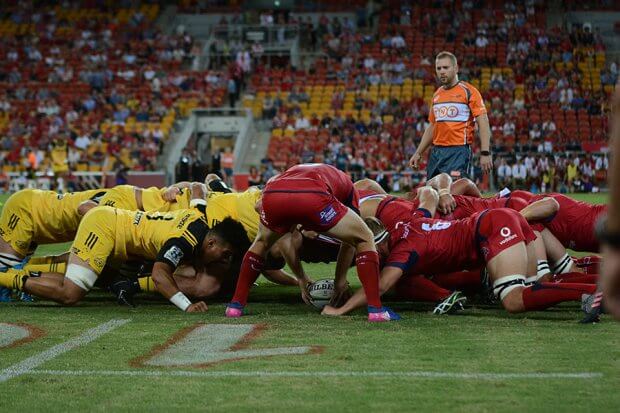Welcome, once again, to the Weekend Edition. I won’t tell you what happened in games on Friday night, and I’m not going to tell you what I think is going to happen in games that’re on Saturday afternoon, or on Sunday. But, I’m not going to stop you talking about those games in the comments; in fact, I’d love it.
So, what will I write about? I’m interested in the news that falls through the cracks each week. I’m hoping to pick up the odd bit of news that comes in after Hoss’s marathon news-gathering efforts on Fridays. If that fails, I may have to make some shit up.
This week I’m going to look at
Is There Something Wrong With The Scrum
With the glut of front row injuries coming out of the Waratahs camp this season, I thought it might be a good time to talk about the scrum and how it’s changed over the years.
Keith will remember the days when there was no difference between a scrum and a ruck and there were no fixed positions, but the rest of us are way too young for that. The South Africans developed the 3-4-1 configuration we use today, and it slowly took over everywhere.

Originally, the offside line was the ball, but the heat of the opposition halfback and his flankers arriving just after the ball got to be too much for all involved. So, the offside line was moved to the rearmost foot of the scrum sometime in the late 1960s.
In the 1990s New Zealand started “winning the hit” and pushing forward as the hooker hooked the ball. This made it nearly impossible for opposition hookers to contest the ball in the scrum, so they simply gave up and pushed instead. It had the added bonus of forcing the defending backline to retreat to stay onside. This changed the scrum into a pushing contest where power was the more important than skill.
Fairly quickly, front rowers started getting injured as teams crashed into each other from as far away as a metre. It was decided that instead of allowing the two packs to control the engagement, the referee would call when to engage. What followed was a decade or more of different calls and systems of varying effectiveness.
Today’s calls are “Crouch, Bind, Set” with the bind call meant to de-power the hit and reduce injuries to front rowers.
I’d suggest most of the problems we have with today’s scrum can be traced back to 1996 and New Zealand’s brilliant tactics to win front foot ball. If the rugby world hadn’t been dealing with the cosmic shift to professionalism, they may have addressed the root of the issue instead of sticking band-aid after band-aid on this bleeding wound.
For me, the root of the issue is the scrum should be a hooking contest and not a pushing contest. The pushing contest is the root of many of the injuries we see today, as players push their bodies. Players are getting bigger and stronger at younger ages, but ligament and tendon growth doesn’t always keep up with muscle growth.
I don’t think you have to be a genius to notice that the majority of players injured are younger. Was it a coincidence that the last two out of the eleven front rowers injured at the Waratahs were also their two oldest? Or that those players had taken on extra workload to cover for the lack of experience of the players called into the squad.
Before 1996, hookers in rugby were smaller and more flexible. With the change in the scrum, the hooker became a virtual third prop, with many physically unable to hook for the ball and reliant on the scrum moving forward for their team to win the ball. How many times have you seen a ball sitting in the middle of a scrum and no one able to get their foot up to hook it?
How to fix it? I think without really knowing it we made a choice in 1996 and for better or worse we chose power over finesse, and now we just have to make the best of the decisions made all those years ago.
Queensland Announce Tongan Tour
How good is this! The Queensland Reds men’s and women’s sides are playing in Tonga on 26 July. Here is the press release.
The Queensland Reds women’s and men’s teams will travel to Tonga on 26 July to play historic international matches against Tonga’s Ikale Tahi national sides at the Teufaiva Sports Stadium.
The matches are part of the ongoing support of Tongan rugby by the Australian Government, Rugby Australia, and the Queensland Reds through the Australia-Pacific Rugby Union Partnership (APRUP). The partnership helps bring our nations closer together through a shared love of rugby union.
The men’s match will be the second international game in a week for the Reds, following the game against Wales at Suncorp Stadium on 19 July. It will also be the first time the Reds women have played offshore in a history now spanning 28 years.
The Tonga tour adds to a blockbuster series of post-Super Rugby games against international and elite club opposition, including Japan’s Saitama Panasonic Wild Knights in November and the Northern Hemisphere tour in January 2025 against European sides, including English club Bristol.
The tour will also provide vital match experience for the Tongan sides ahead of the Pacific Nations Cup and Tonga’s qualification for World Rugby’s new WXV women’s rugby tournament.
The tour has the support of the Australian Government’s PacificAus Sports program and will include community and high-performance activities in Tonga ahead of the matches. These activities include coaching clinics, women in rugby leadership sessions, and community school visits to enhance inclusive rugby pathways in Tonga and further strengthen Australia and Tonga’s close ties.
This will be the first time Queensland Reds men have played Tonga since 1995 and will be the first-ever match-up for the women.
https://reds.rugby/news/historic-tonga-tour-announced-for-queensland-reds-2024517
That’s it from me. Have a great weekend and I’ll see you in the comments.

